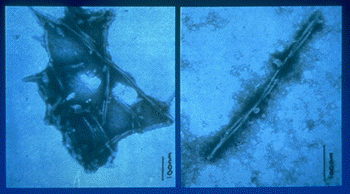 In its normal, non-infectious
state, the prion protein (PrP) is a hydrophobic glycoprotein that is "soluble
in the presence of significant quantities of non-polar water miscible solvents".
Spectroscopic data and computer simulations by Cohen et al have indicated
a compact bundle with four alpha-helices at the core and complex oligosaccharides
linked to protein. PrP is highly conserved across many species, including
humans, sheep, mice, hamsters, Drosophila and bovine, suggesting an important
function in neurons. It occurs as a GPI-anchored protein on the surfaces
of neurons and is a widely expressed product of normal cellular function.
Although it is suspected that the prion protein is involved in synaptic
activity, its function is not yet known. In mice, excessive amounts
of normal (non-infectious) PrP can lead to neurodegeneration and destruction
of both muscles and peripheral nerves.
In its normal, non-infectious
state, the prion protein (PrP) is a hydrophobic glycoprotein that is "soluble
in the presence of significant quantities of non-polar water miscible solvents".
Spectroscopic data and computer simulations by Cohen et al have indicated
a compact bundle with four alpha-helices at the core and complex oligosaccharides
linked to protein. PrP is highly conserved across many species, including
humans, sheep, mice, hamsters, Drosophila and bovine, suggesting an important
function in neurons. It occurs as a GPI-anchored protein on the surfaces
of neurons and is a widely expressed product of normal cellular function.
Although it is suspected that the prion protein is involved in synaptic
activity, its function is not yet known. In mice, excessive amounts
of normal (non-infectious) PrP can lead to neurodegeneration and destruction
of both muscles and peripheral nerves.
 In humans, the gene which codes for the prion protein has been traced to
the short arm of chromosome 20 (specifically, 20p12-pter). Within
the 20p12-pter region, Schnittger et al (1992) have demonstrated the loci
to be: pter-PrP-SCG1 (118920-BMP2A(112261)- PAX1(167411)-cen.
The entire PrP gene has been sequenced and determined to consist
of two exons and a single intron with one major transcriptional start site.
Further, the region immediately 5' of the transcriptional initiation site
in human PrP genes contains many GC repeats, a characteristic common in
housekeeping genes. Also 5' of the PrP gene is a RFLP (Restriction
Fragment Length Polymorphisms) that has a high degree of heterozygosity
and serves as a marker for the pter-p12 region of chromosome 20.
Current research indicates that there are 13 known alleles for the human
prion gene based on point mutations and substitutions.
In humans, the gene which codes for the prion protein has been traced to
the short arm of chromosome 20 (specifically, 20p12-pter). Within
the 20p12-pter region, Schnittger et al (1992) have demonstrated the loci
to be: pter-PrP-SCG1 (118920-BMP2A(112261)- PAX1(167411)-cen.
The entire PrP gene has been sequenced and determined to consist
of two exons and a single intron with one major transcriptional start site.
Further, the region immediately 5' of the transcriptional initiation site
in human PrP genes contains many GC repeats, a characteristic common in
housekeeping genes. Also 5' of the PrP gene is a RFLP (Restriction
Fragment Length Polymorphisms) that has a high degree of heterozygosity
and serves as a marker for the pter-p12 region of chromosome 20.
Current research indicates that there are 13 known alleles for the human
prion gene based on point mutations and substitutions.
 In sheeps, there are 8 known alleles for the prion protein. each
allele is a result of a point mutation within the gene, with allele frequencies
varying between breeds and flocks. While most of the alleles have
been found in healthy sheep, the PrPMARH allele is associated with a high
incidence of scrapie. Sequencing of sheep PrP coding sequence indicates
homologous regions between sheep and human genes. As in humans, very
little is known about the function of the normal prion protein in sheep
neurons.
In sheeps, there are 8 known alleles for the prion protein. each
allele is a result of a point mutation within the gene, with allele frequencies
varying between breeds and flocks. While most of the alleles have
been found in healthy sheep, the PrPMARH allele is associated with a high
incidence of scrapie. Sequencing of sheep PrP coding sequence indicates
homologous regions between sheep and human genes. As in humans, very
little is known about the function of the normal prion protein in sheep
neurons.
 In bovine, the PrP gene alleles vary in the number of GC elements (either
5 or 6) which code forthe octapeptide (oligosaccharide) Pro-His-Gly-Gly-Gly-Trp-Gly-Glu,
or its longer variants Pro-Glu/His-Gly-Gly-Gly-Gly-Trp-Gly-Glu,
creating polymorphism. Further, a silent Hindll restriction site
polymorphism occurs in the bovine PrP gene with no known affect on function.
The protein is normally found in skelatal muscle (steak) and lymphocytes
in milk (along with neural membranes). Similarly to sheep and humans,
very little is known about the normal protein's functions in cows.
In bovine, the PrP gene alleles vary in the number of GC elements (either
5 or 6) which code forthe octapeptide (oligosaccharide) Pro-His-Gly-Gly-Gly-Trp-Gly-Glu,
or its longer variants Pro-Glu/His-Gly-Gly-Gly-Gly-Trp-Gly-Glu,
creating polymorphism. Further, a silent Hindll restriction site
polymorphism occurs in the bovine PrP gene with no known affect on function.
The protein is normally found in skelatal muscle (steak) and lymphocytes
in milk (along with neural membranes). Similarly to sheep and humans,
very little is known about the normal protein's functions in cows.
|

![]()

![]()

![]()